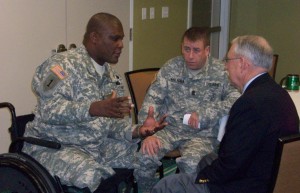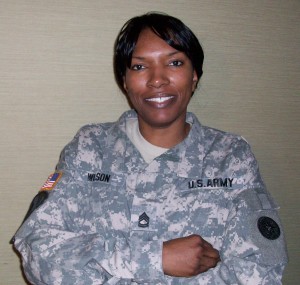By Emily Oehler, WTC Stratcom

A former COAD Soldier retired GEN Fredrick Franks (right) discusses ways to improve the Army COAD/COAR process with AW2 Director COL Greg Gadson (left) and AW2 Sergeant Major SGM Robert Gallagher (center).
For most of the AW2 Continue on Active Duty/Continue on Active Reserve (COAD/COAR) Forum delegates, their determination to find ways to improve how the Army manages those who are unfit for duty post injury but who remain in the Army is about “those that will follow.” It’s a responsibility they take very seriously. In fact, SGT Molly Holub, a Military Police dog handler, ended her pre-deployment leave three days early to attend and support the Army’s efforts to update the COAD/COAR system.
This morning during a breakfast session, the delegates heard from a decorated Soldier who paved the way for them—and still does. GEN Frederick Franks, a retired general and COAD Soldier, spoke to the delegates about what he described as the “hot blue flame of passion and drive to continue to serve.”
“All the males in my Family and community served in WWII [World War II],” Franks shared. “I was taken by their selflessness and pride in what they’d done—their willingness to serve. I wanted to earn the right to lead people like that, so I attended West Point.”
An injury, while serving in Cambodia in 1970, resulted in the amputation of Franks’ left leg below the knee. He went through the Medical Evaluation Board (MEB) in July 1971 and knew immediately that he wanted to COAD. “It’s my life. I love being a Soldier,” added Franks.
Regulation AR 635-40 was in place back then, and Franks said, “It’s pretty much the same process, MEB, PEB [Physical Evaluation Board], and COAR that exists today.” He added, “After 10 years at war, it’s time for the Army to take it to the next level with the appropriate resources. I have great admiration for the establishment of AW2, but now they need to bump it up a notch.”
After meeting and talking with several of the current COAD Soldiers, Franks commented, “I am honored to be in their presence and admire their resiliency—to get up and go on. I am inspired by their continuation to serve.”
Franks charged commanders, “Look at the COAD/COAR Soldiers’ abilities and utilize them accordingly. Don’t artificially constrain or put limitations on them. Ask them. Engage them. Talk to them. Learn where they can best serve and whether or not their talents are being served or whether they could be better utilized somewhere else. They have an enormous amount to give—but we have to give them the opportunity.”
“I know for me, being able to continue to serve after my left foot was amputated, is one of my life’s greatest privileges.”




